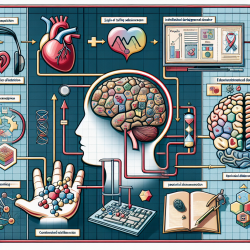Introduction
The study titled "Inhibition of G-protein signalling in cardiac dysfunction of intellectual developmental disorder with cardiac arrhythmia (IDDCA) syndrome" offers groundbreaking insights into the complex mechanisms underlying IDDCA syndrome. This condition is characterized by cognitive disabilities and severe cardiac arrhythmias, particularly bradycardia, due to pathogenic variants in the GNB5 gene. As practitioners in the field of special education and therapeutic services, understanding these mechanisms can significantly enhance our approach to managing and supporting individuals with IDDCA syndrome.
Understanding the Research
The research explores the role of GNB5 in heart sinus conduction and its essential function in parasympathetic control of heart rate. The study utilized Gnb5-null mouse models to mimic the human condition, revealing that the loss of GNB5 leads to higher baseline heart rates due to diminished parasympathetic control and increased sympathetic regulation. This imbalance results in profound bradycardia upon treatment with carbachol, a cholinergic agonist, while sympathetic modulation remains unaffected.
Practical Implications for Practitioners
For practitioners, these findings underscore the importance of a nuanced understanding of autonomic nervous system regulation in IDDCA syndrome. By recognizing the altered parasympathetic and sympathetic balance, therapists can tailor interventions to better support cardiovascular health in affected individuals. Here are some practical steps to consider:
- Holistic Assessment: Regular monitoring of heart rate and rhythm in individuals with IDDCA can help identify arrhythmias early, allowing for timely interventions.
- Therapeutic Strategies: Incorporating stress-reduction techniques and exercises that promote parasympathetic activation could potentially mitigate some cardiac symptoms.
- Collaborative Care: Working closely with cardiologists to develop comprehensive care plans that address both cognitive and cardiac aspects of the syndrome.
Encouraging Further Research
While this study provides valuable insights, it also opens the door for further research. Practitioners are encouraged to explore additional therapeutic modalities that could complement existing treatments. Investigating the potential of pharmacological agents that specifically target G-protein signaling pathways may offer new avenues for managing IDDCA syndrome.
Conclusion
The research on G-protein signaling in IDDCA syndrome is a testament to the power of scientific inquiry in enhancing therapeutic practices. By integrating these findings into our work, we can offer more targeted and effective support to individuals with this complex condition. For those interested in delving deeper into the study, the original research paper can be accessed here: Inhibition of G-protein signalling in cardiac dysfunction of intellectual developmental disorder with cardiac arrhythmia (IDDCA) syndrome.










